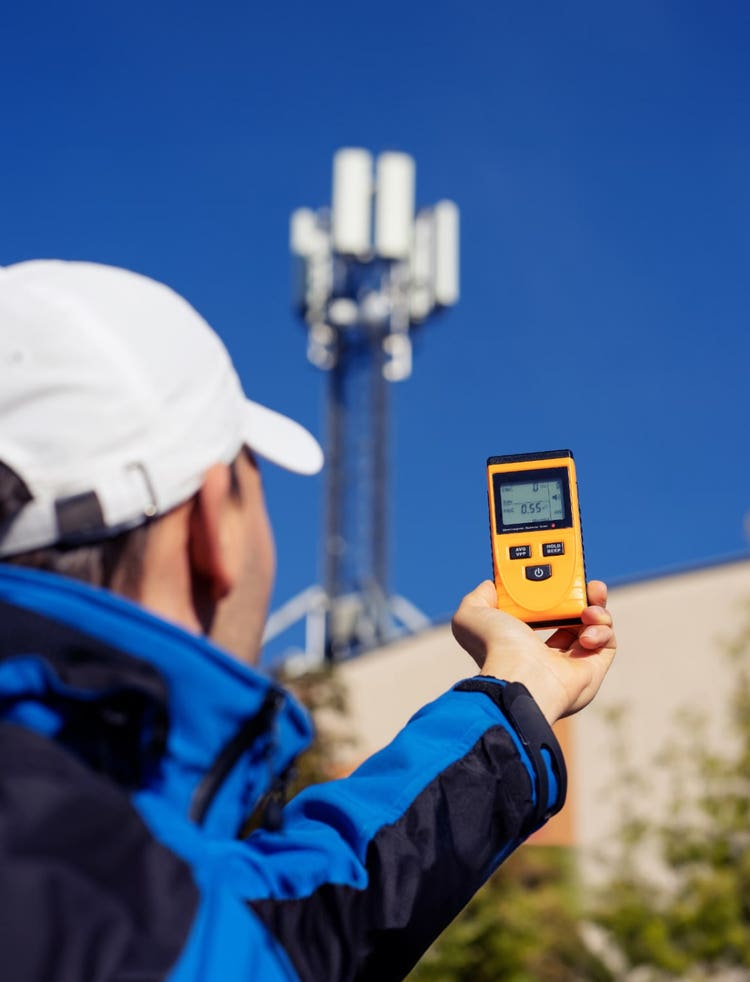

Insights
Understanding EMF safety in 5G networks
Rajeev Gandhi, Head of Technology, Telco Network Engineering
UST's telecommunications specialists offer tailored solutions to optimize network design, mitigate EMF exposure, and ensure compliance with regulatory standards.

Rajeev Gandhi, Head of Technology, Telco Network Engineering
The global telecommunications industry is abuzz with anticipation over the transformative potential of 5G—for faster data transmission speeds, lower latency, higher network capacity, increased availability, and better reliability. In fact, according to this article from CNBC, many global telecom providers have already bid $81 billion on 5G spectrum licenses.
Yet, alongside the promises of enhanced connectivity looms a concern: the impact of radio frequency (RF) electromagnetic fields (EMF) emitted by 5G networks. Deploying 5G technologies is associated with this and other challenges. Telecom providers are working tirelessly to devise strategic and actionable plans to manage them and mitigate failure risks. In this insightful blog, we delve into the intricacies of 5 G's relationship with EMF safety and explore strategies to mitigate associated risks. Telecom providers are working tirelessly to devise strategic and actionable plans to manage the challenges and mitigate failure risks.
DIVIDER
EMF's Role in Telecommunications
The EMF plays a crucial role in determining several design aspects of 5G infrastructure, like maintaining magnetic poles at the proper locations, preventing ionic particles from charging the air, and so on.
DIVIDER
What is EMF, and how does it work?
As the Earth's outer core is in constant motion in a particular direction at high speed, a massive magnetic field, called the magnetosphere, is generated. This giant EMF acts as a protective layer around the Earth, and it prevents solar-charged winds from touching the Earth’s surface and causing damage. In addition, EMFs also maintain the flow of current from one location to another over the Earth's surface. If there are changes to the magnetosphere and the associated EMFs, or they somehow stop working to protect the Earth, life on Earth could be severely affected.
According to this article from the National Aeronautics and Space Administration, scientists speculate that Mars “lost its magnetosphere about 4.2 billion years ago. The solar wind likely eroded much of Mars' atmosphere, whereas Earth's magnetosphere has safeguarded our own. Without this magnetic shield, our atmosphere might be drastically altered, potentially impacting life as we know it. Thus, protecting the magnetosphere is crucial for preserving life on Earth, necessitating careful measures to avoid unintended consequences.
DIVIDER
Can 5G adversely impact the Earth’s EMF?
The 5G wireless telecommunications technology was launched to reduce the latency and speed of cellular data transmission when we use wireless cellular devices. In addition, 5G offers more protection between different communication channels to prevent signal interaction, wave imposition, and many other forms of interference. The array of benefits and business opportunities presented by 5G surpass those offered by 4G (LTE) and 3G, making it imperative for telecommunication companies.
The Earth's EMF emits different waveforms, including UV rays, visible frequencies, and microwaves. However, the RF wave can cause the maximum damage. With the rollout of 5G technology, government officials and environmentalists have raised questions about the potential for increased radiation levels in the Earth’s atmosphere once 5G network rollouts are complete. While many scientific sources say the EMFs associated with 5G technologies aren’t harmful to humans, others who say we don’t know enough yet.
According to a report from Forbes, "One concern is that due to the novelty of 5G, there hasn't been sufficient time to conduct thorough safety testing. Some experts also note a dearth of scientific studies on the potential effects of densely concentrated 5G areas in urban centers or prolonged exposure to 5G." Given our incomplete understanding of its health implications, inadequate management of radiation levels could lead to various potential negative consequences.
DIVIDER
Health effects of EMF from 5G
First, prolonged exposure to a high volume of RF waves can damage biological cells. Therefore, several health issues, such as different kinds of cancer, could arise if the RF waves radiating from 5G base stations and devices are not controlled within the safe limit.
The Earth's surface temperature can also increase if RF waves are not controlled within appropriate levels. This could negatively impact the environment, such as an increase in global warming, changes in air pressure and wind patterns, and ionization in the atmosphere, which can lead to extreme cloudiness.
DIVIDER
Maintaining EMF safety after a 5G rollout
The International Commission for Non-Ionizing Radiation Protection (ICNIRP), an independent scientific organization that sets guidelines for safe EMF exposure, released guidelines for limiting RF-EMF exposure to cellular networks in 1998. Every telecom provider needs to comply with the latest guidelines to protect consumer health and other life forms.
To ensure the RF-EMF exposure is controlled, telecom providers must plan the rollout of 5G technology based on the allowable RF limit. According to the ICNIRP’s 2020 updated guidelines, 6 GHz is the safest maximum frequency threshold for RF waves released from communication network components and end devices.
If a telecom provider wants to roll out 5G with higher frequency bandwidth, they need to obtain special permission from regulatory bodies. Also, the telecom provider needs to focus on other safety and health standards that can help offset or reduce the negative impacts of RF exposure for a prolonged time.
Additionally, 5G network operators should reconfigure antenna positioning and directional lines at several locations so that the frequencies cannot interact with other communication devices. For instance, data transmission and control towers near airports can interfere with the RF frequencies used in an airport's radar technology.
DIVIDER
UST: Your Partner in EMF-Safe 5G Networks
Architecting a robust 5G infrastructure that balances performance with EMF safety demands expertise and precision. UST's telecommunications specialists offer tailored solutions to optimize network design, mitigate EMF exposure, and ensure compliance with regulatory standards. Partner with us to navigate the complexities of EMF safety in the 5G landscape.
Unlock the potential of 5g safely with UST's expertise. visit us at ust.com to learn more.